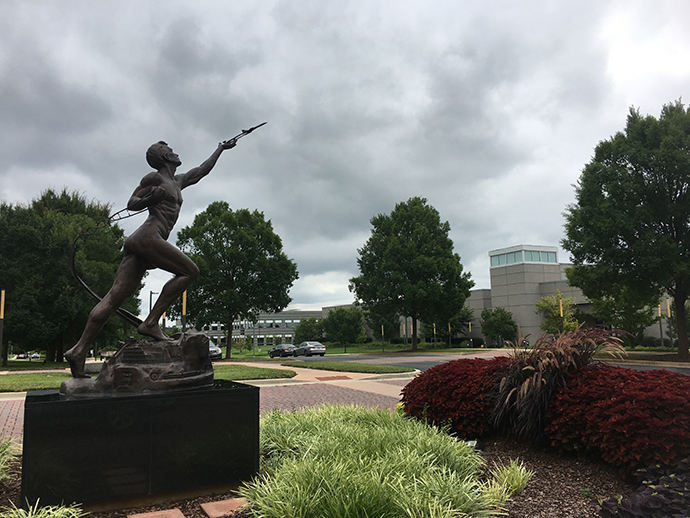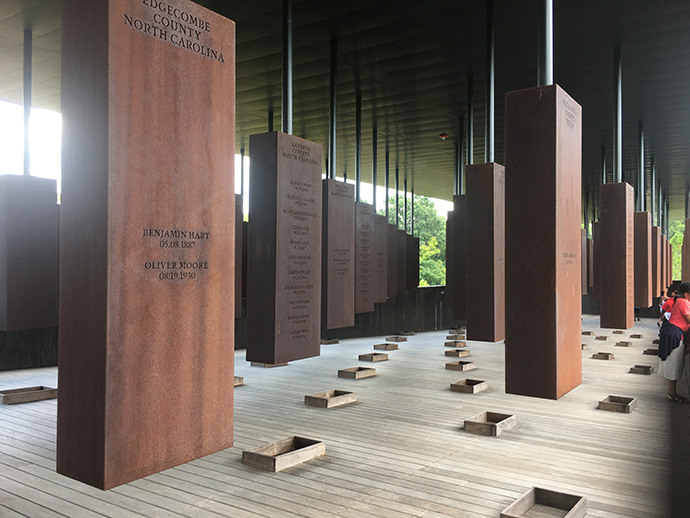When Hyundai Motor Manufacturing Alabama (HMMA) in November announced a $410 million, 200-job expansion in order to add production of its Santa Cruz compact utility vehicle to its lineup, Sheron Rose, senior vice president, external affairs, for the Montgomery Area Chamber of Commerce, was thrilled on many levels, in part because she worked for the automaker’s HR department for many years.
“I had the opportunity to talk with a few of the team members after the announcement,” says the Tuskegee University graduate, a native of Dothan. “They are proud of the confidence Hyundai has placed in them to expand at their only U.S. facility rather than locate elsewhere.”
Local suppliers and logistics companies who support HMMA are projected to employ an additional 1,000 people in Montgomery and the River Region because of the expansion.
HMMA, which started vehicle production in May 2005, is the River Region’s largest private manufacturer with 2,900 full-time and 500 part-time employees. In 14-and-a-half years the plant has produced 4.5 million vehicles for the North American market. In the past 18 months alone, HMMA has invested over $1.1 billion in the Montgomery area.
“I recently had the honor of experiencing first-hand the long-standing partnership between Hyundai and Montgomery on a visit to Seoul as part of an economic development delegation including former Mayor Todd Strange,” said newly elected Montgomery Mayor Steven Reed. “With the addition of the Santa Cruz, Hyundai is again choosing to launch a new vision.”
Automotive growth is not confined to Montgomery. In remarks at a North Alabama Industrial Development Association luncheon in Atlanta in December, Ted Clem, director of business development for the domestic division at the Alabama Department of Commerce, noted that while the University of Alabama may be missing out on a championship football game this year, the university’s home state just had a championship year, to the tune of $8.7 billion of investment and 17,026 new jobs in 2018.
“The auto sector is continuing to be a major player in this growth,” he said, noting the Mazda-Toyota investment in Huntsville. “In 2018, $3.3 billion in capital investment was announced, creating 5,477 jobs. This story is going to continue as a lot of new suppliers have either announced or are getting ready to.”
Among U.S. states, Alabama is already the fifth largest producer of cars and light trucks. The state has more than 150 major auto suppliers and 57,000 automotive manufacturing jobs. When all levels of suppliers are tallied, north Alabama alone has 114, and that number is set to quickly increase as Mazda-Toyota gets set to launch full production by 2023.

As great as the state’s economy has performed since the Accelerate Alabama strategic plan was first introduced in 2012, Clem says “we are in a transformative stage. Technology is disrupting industries, and we know we can’t count on more of the same. We must focus on jobs ruled by brainpower.”
That’s driven state leaders to continue tweaking what was already an effective set of incentives programs: Since the 2015 Alabama Jobs Act modernized the state’s approach, approximately $1.7 billion in incentives have supported $10.5 billion in capital investment, and new jobs across a number of industries carrying an average wage of $23.04 an hour — significantly higher than the Alabama median wage of $15.77.
The state legislature in 2019 took incentives a step further with the Alabama Incentives Modernization Act (AIMA). The jobs credit for tech companies can include an additional 2% above the standard credit. And Jobs Act incentives now extend to high-tech companies creating at least five jobs, not 50, as before. The AIMA also provides enhancements for rural areas, with 13 new counties now eligible for enhanced incentives as targeted counties. The target for job creation incentives is now lowered to 10 jobs from 25; and the investment credit is extended to a maximum of 15 years for projects in rural counties.
Meanwhile, another plan from Gov. Ivey called Success Plus aims to add 500,000 high-skilled employees to Alabama’s workforce by 2025.
Montgomery Momentum
A good number of those jobs may be coming to the River Region around Montgomery, if local leaders and employers have anything to say about it. Sheron Rose works closely with workforce development partners in the region, and knows how well all the players have aligned for HMMA’s growth.
“Governor Ivey’s Office of Workforce Development, Alabama’s Workforce Development Council, the two-year college system, along with the state and local offices of career tech education, have focused on making sure that training, certification and apprenticeship programs are utilized in varied vocations,” she says. In addition to IT and STEM initiatives such as MGMWERX and TECH MGM, Montgomery Public Schools’ MPACT program allows students to earn basic certifications in a number of areas including welding, electronics, IT and industrial maintenance. The school system also offers dual enrollment opportunities in partnership with Trenholm Community College.
In addition, AIDT (Alabama Industrial Development Training) has a new basic machining program that is offered to the general public, free of charge, through the Montgomery Regional Workforce Training Center (MRWTC) located at ONE Center, where students also can obtain IT, manufacturing and workforce skills training. Known more for its customized training programs across the state, AIDT currently is working with 132 companies in 36 counties.
“Technology is a large component of the increased training programs,” Rose says. “HMMA is also working directly with Trenholm to enhance and increase the skills of their current production team members. During the summer months, dependents of team members are provided the opportunity to work and gain skills in production. This program emphasizes the family-oriented environment of the company.”
Rose says the family focus jibes well with good old Southern hospitality. The stories just keep flowing.
“I can remember going out to dinner when I was first hired by HMMA in 2003,” she says. “People would stop and shake our executives’ hands and say, ‘Thank you.’ ” Rose drove a Hyundai-issued vehicle. One night, she says, “I had a sheriff blue-light me all the way into my driveway. He walked up and said, ‘I just wondered how you like the car.’ ”
And even as the Korean company’s production system and continuous improvement philosophy influences the workforce, Alabama has influenced Hyundai too.
“When Alabama played in the national championship game,” Rose says of one of many appearances by the Crimson Tide football team, “we said they should not run the line. They said, ‘What?’ I think 100 cars rolled off that day — the usual number would have been 1,500. They had management working on the line. The next time, they made an adjustment.”
“When we got into the automotive race, Alabama already had Mercedes and Honda,” says the now-former Mayor Strange, whose resume includes 25 years in the corporate world and service as Alabama’s director of commerce. “The general thinking was anything south of that was too far south. So when we were able to be successful with the Hyundai plant, the whole geography of the industry moved a bit south. Now Huntsville, where you see a lot of the automotive coming, may in fact be the epicenter. We’re in the top three states now, and the governor would tell you in a year or two, we may be number two in terms of units produced.”
Strange has his own story of how hospitality and genuine connection can supersede other considerations — to an extent.
“We’ve never been the biggest incentive piece,” he says. “We were involved in a project down to the final two a couple years ago, $300 million and 1,000 jobs. We lost by $100 million in incentives.” The project went to Mississippi instead. “But the company was so impressed with us, the vice chairman came here to personally tell us they could not turn down $100 million, but they wanted a relationship with Montgomery,” Strange says. “We ended up having a five-year commitment to sponsor an LPGA tournament, at $3 million a year.”
Come on down to the Montgomery-area town of Prattville in May for the Yokohama Tire LPGA Classic. You’ll be greeted warmly.
Military Base Just One Catalyst for Change
Another major institution making adjustments is Maxwell-Gunter Air Force Base, located on the site of the Wright Brothers’ first civilian flying school. The base today is the headquarters of Air University, a major component of Air Education and Training Command that graduates more than 50,000 resident and 160,000 non-resident officers, enlisted and civilian personnel each year. The base also is home to one of the Air Force’s largest network operations squadrons. TechMGM Executive Director Charisse Stokes, who served on the base, says that not only means 250 cybersecurity experts inside the gate, but tremendous opportunities in terms of contractors. About 7,000 military, civilians and contractors are assigned to Maxwell-Gunter.
TechMGM works to marshal the base’s intellectual firepower as it leads initiatives in IT training, mentoring an increasing number of protege companies in the area, taking advantage of the major internet exchange point in the city, and even playing a role in the passage of a new law in 2019 that will see computer science programs in all Alabama schools by 2023.
Among the new firms arriving to Montgomery’s tech scene is digital services and software firm Fearless, whose new contract with the Air Force and the chamber will mean new jobs in Montgomery even as it also expands its Baltimore HQ.
“What really intrigued us was the focus on the community in Montgomery. The socioeconomic, social justice and tech ecosystem needs closely parallel what we encounter in Baltimore,” said Fearless founder Delali Dzirasa last spring.
Moral Tourism
Another powerful part of Montgomery’s identity today is the twin establishment of the Equal Justice Initiative (EJI) and the National Memorial for Peace and Justice, perched on a hill overlooking downtown. Both were founded by Bryan Stevenson, whose book “Just Mercy” (just made into a feature film) depicts his work on behalf of the unjustly imprisoned and other victims of institutional racism. The memorial stuns most visitors, as it features hundreds of steel monolithic monuments to lynching victims across the nation, and calls communities to confront ugly truths rather than sweep them under the rug.
“The EJI is a great example of how to take American tragedies and educate people about atrocities that happened, and at the same time, create jobs and tax flow,” says Montgomery Area Chamber of Commerce Chair Willie Durham.

To that point, travelers spent $972 million and were responsible for 13,817 jobs in 2018 in Montgomery County, a 15.5% increase in traveler spending on hotels, restaurants, shopping and transportation from 2017. As of April 2019, year-to-date hotel room nights were up 24,000 over the same four months in 2018. Most of that activity was attributable to the EJI and memorial.
“Five to seven years ago, I was looking at Time magazine on a Saturday morning, reading about the 100 most influential Americans,” says Mayor Todd Strange. “I was wondering who from Alabama was on this list, and saw a guy named Bryan Stevenson. I didn’t know him. I read it, and thought, ‘Wow, he’s right across the street. Been here 20 years. I should meet him.” So right in this restaurant, Bryan and I had our first meeting.”
Stevenson first negotiated with the mayor to place half a dozen signs around downtown to memorialize the slavery pens and market. A year later, Stevenson came to the city again proposing the legacy museum idea, for which he was considering Montgomery and Memphis.
“We showed him a piece of property that had been a big apartment complex overlooking the city,” Strange says. “We sold that and the surrounding properties to him. He gave us a day’s heads up before he announced it on Oprah’s show. First call was from a reporter at The New Yorker, followed by CNN. The reporter said, ‘Mayor, how does it feel to have the only lynching museum in the US of A?’ I said, ‘History has not always been a pretty picture. The good news is he’s chosen to do it in Montgomery.’ People can reconcile it, make sure it never happens again, come to see it and confront it. Five hundred thousand people later in the last 14 months, they’ve come. I’d like to tell you we’ve dealt with the mass crowds well. We’re learning what it means to be a destination city. We get so many compliments from individuals about how appreciative they are that this subject has come to the fore. They say, ‘It’s changed how we feel about Montgomery, Alabama and the South.”
The visibility of the area has increased new ties and renewed old ones: Rose says she knows of several people connected with Hyundai business who have discovered family connections in the area. Durham says several relatives who migrated to Chicago or Detroit during the Jim Crow era are returning to their roots to retire.
Companies are setting roots too: More than $1 billion in industrial capital investments in 2019 marked the second largest number ever for Montgomery County, only surpassed by the 2002 original Hyundai announcement. A total of 31 expanding or locating companies created 1,214 new jobs, and helped secure 7,784 existing local jobs.
Birmingham Voices
Talk to Birmingham’s movers and shakers, and you’ll understand why the city’s outlook is rosy, led by Mayor Randall Woodfin, organizations such as the Birmingham Business Alliance and a growing cadre of entrepreneurs.
“We need to build access points into our economy. If you truly care about shared prosperity — not just economic growth, but truly care about building an inclusive economy where everyone has a shot — it takes systematic thought to upend the systemic oppression which was created in my office, where Sheriff Bull Connor used to sit,” says Josh Carpenter, director of economic development for the city and a business professor at the University of Alabama-Birmingham. “It means you can’t afford to pass up on tools like Opportunity Zones. And it means you have to explain why, in a city like Birmingham, inclusion and economic growth are one and the same. They’re intertwined.”
The city has re-engineered its incentives in order to encourage local hiring, and is creating an incentives program for small business, says Carpenter. Startups such as Mixtroz, Shipt and Therapy Brands have injected energy into the entrepreneurial scene. And the city has launched a new apprenticeship program in tandem with the Birmingham Promise, whereby Birmingham City Schools students can receive scholarships to a two- or four-year college.

The city’s first Opportunity Zone deal is a project big-city mayors such as L.A.’s Eric Garcetti have pointed to as a model. PNC is bringing $15 million and the city is contributing funds to help transform the vacant, nearly century-old Stonewall office building into much-needed workforce housing in downtown Birmingham, with rents between $700 and $900 a month. The building will re-open as the American Life Building in late 2020.
“We know that there are restaurant and retail workers, grad students, health care workers and professionals starting their careers, who would choose to live in the City Center if only they could make the rent,” said Ed Ticheli, project owner and developer. “They want to be a part of this incredible renaissance happening in Birmingham.”
“For decades, this neglected building has been a constant reminder that even though there are pockets of prosperity in the Magic City, hardship still persists here,” said Mayor Woodfin. “As a city, we are working to change that.”
‘An Ecosystem That Supports You’
One of the city’s change-makers is Ashlee Ammons, president and co-founder of Mixtroz along with her mother Kerry Schrader. The company, which creates community at events by increasing engagement and collecting data, joined the Velocity Accelerator in Birmingham in 2018, and achieved velocity almost immediately. In May 2018, the duo was selected to pitch to AOL Co-Founder Steve Case during the Rise of the Rest tour stop in Birmingham, and secured a $100,000 investment from Case’s Revolution Fund. The team went on to close a $1 million round of funding, making them the 37th and 38th black females to ever close a million-dollar round of funding.
“The accelerator was amazing — I likened it to an executive MBA,” Ammons says. Even more amazing was what happened after winning the $100,000 seed check from Case’s organization.
“It took us six months, and we raised the other $900,000 from local investors here in Birmingham,” says Ammons. “We said, ‘This is a no-brainer, we need to be headquartered here. One of the biggest pieces of advice I give entrepreneurs is, if your ecosytem is not supporting you, but are ‘on board,’ get out of there. When you find an ecosystem that gets you and supports you, that’s where your business should be.”
Ammons calls Mayor Woodfin “an extraordinary leader to have in Birmingham at this time. He brings a certain amount of swagger, but his business sense is dead on. And he’s a mayor who is tech forward — amazing. He gets that we have to train up these students matriculating through the schools. And hopefully they will want to stay in Birmingham.”
Ammons, a native of Cleveland who interned with LeBron James and worked in New York for years, admits the city can seem a bit small for her — “I’ve never been accustomed to running into people I know at Target,” says Ammons — but because it’s smaller, she says, “they can fail fast and pivot.” More important, she says, is “a symphony among the civic, corporate and tech ecosystems right now. Those three things are magic when working together.”

